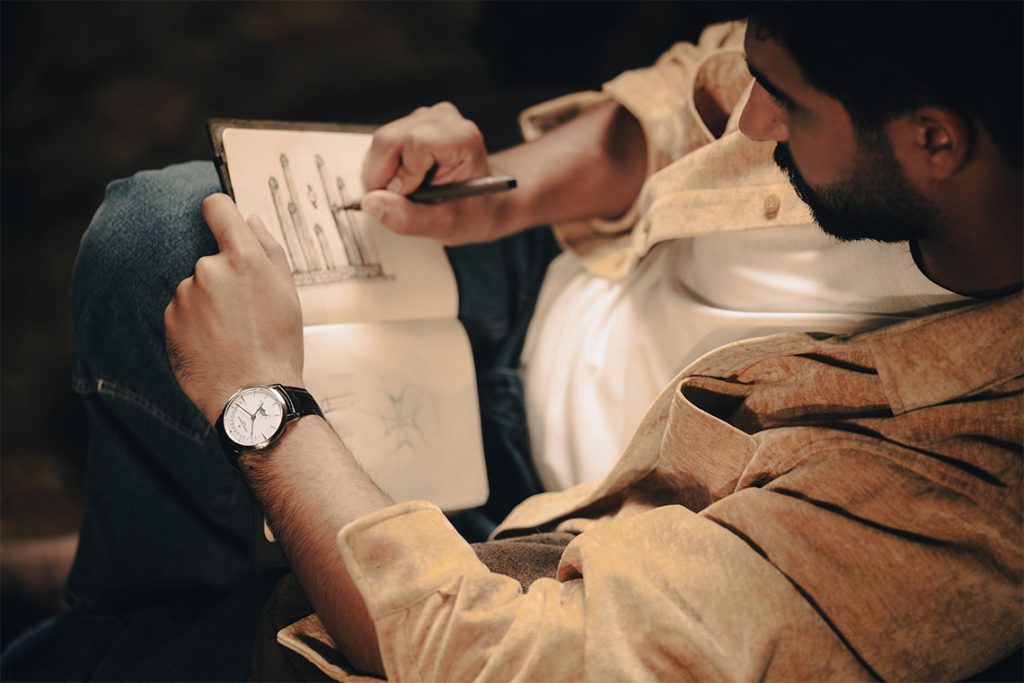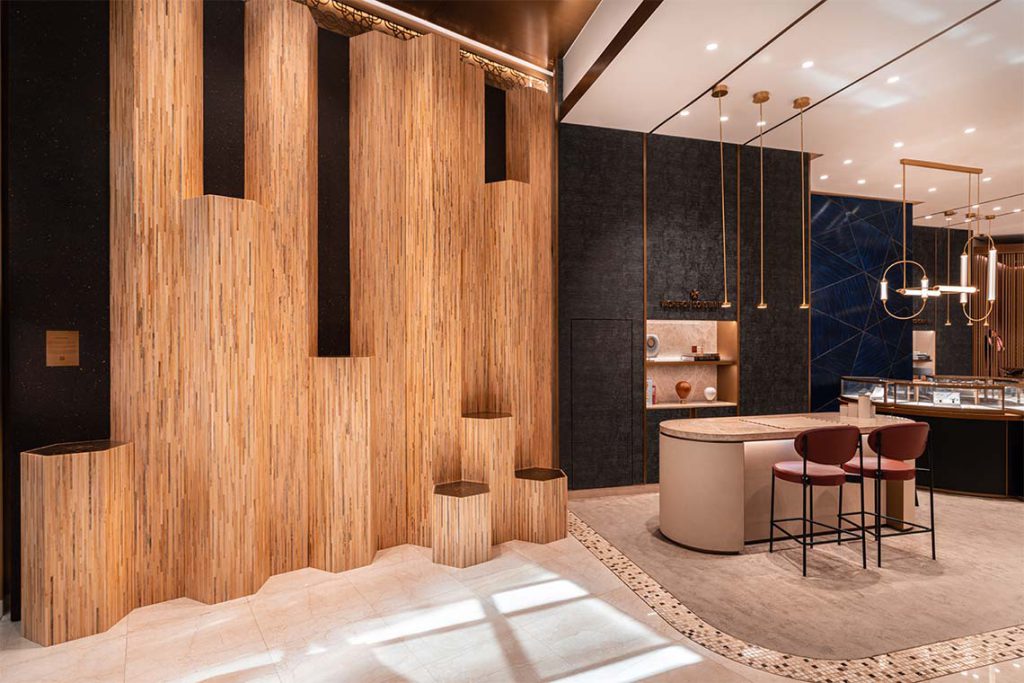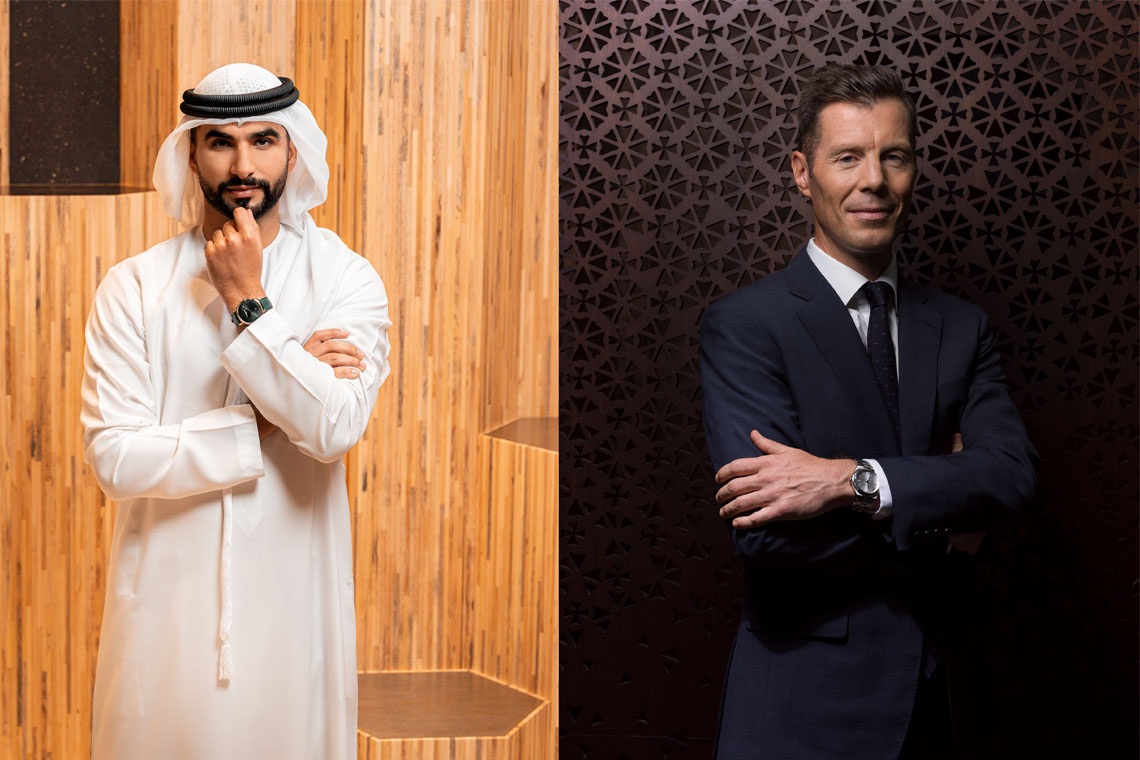The Emirati artist and Vacheron Constantin’s Managing Director discuss the artistic collaboration Among the Pillars, an installation exhibited at the Maison’s boutiques across the Middle East during the month of Ramadan.
Canvas: How did this collaboration come together?
Christophe Ramel: The partnership with Omar Al Gurg was one of mutual respect and a shared vision. His unique artistic language, one that captures the rich Emirati heritage with a contemporary pulse, aligns seamlessly with Vacheron Constantin’s dedication to the art of watchmaking, which similarly blends tradition with innovation. His use of local materials and his contemporary yet reverent approach to Islamic motifs and Middle Eastern landscapes embody the brand’s dedication to cultural craftsmanship and artistic excellence. His ability to create a dialogue between past and present made him the ideal artist for our Ramadan project this year.
What was the source of inspiration for Among the Pillars?
Omar Al Gurg: I was inspired by a combination of Arab architecture and nature. One of the most common structures you see in local architecture is pillars, which hold up buildings and cover their ceiling span to create shade. The same thing occurs in nature, where the fronds of the palm tree create shade for people walking underneath. I took inspiration from other aspects of our culture as well, such as local materials that are made by repurposing the discarded fronds and date seeds from palm trees. Among the Pillars is a poetic way of using this waste material to create an installation that is reminiscent of architecture.

Tell us more about these materials. How are they produced? What was behind your choice to use them?
OG: One of the materials is PlyPalm, which is plywood made out of the leftover fronds of the palm tree. It’s customary to chop off the bottom fronds to allow more branches to grow, and these were traditionally used to create walls, roofs or baskets. To make PlyPalm, the middle stems of the fronds are separated and stuck together. DateForm, the other material, is made out of date seeds, which are pulverised and made into a resin that is quite sturdy and can be used for wall cladding or flooring.
PlyPalm and DateForm are not very old materials, but with Among the Pillars they’ve been used to an extreme level because the installation is four metres high. This kind of experimentation could help the manufacturers of the materials understand what is commercially feasible for them. Our reason for choosing these materials was also because they’re sustainable in the sense that they are very hardy and can last a long time, and the work can be taken down and reused. We’ve been discussing turning it into a public art installation. Beyond that, the work is also about celebrating what our land has to offer.
CR: The materials also speak to the culture and history of the Middle East, as well as showcasing the Maison’s profound engagement with the local community. PlyPalm repurposes palm tree fronds into elegant hexagonal pillars that reflect the region’s cultural legacy and the ancient practice of tracking time through shadows from such pillars. DateForm, which adds a distinct texture to interiors, represents Ramadan’s cultural heritage, forming the backdrop for this art installation.
How does the installation respond to Vacheron Constantin’s annual theme for this year, Less’ential?
CR: Less’ential is a play on the idea that less is more and essential. In collaboration with Omar, we’ve incorporated this theme by embracing the minimalist aesthetics that reveal the heart of our brand’s philosophy. Among the Pillars captures the spirit of the theme, celebrating the powerful simplicity found in design.
OG: The installation is a kind of abstraction of the ornamental architectural style we have in the UAE. It also simplifies the materials, in a way that’s new to the eye but, at the same time, mimics shapes that exist in nature. For example, we stripped down palm trees to create a simple form that still resembles the trees.

Image courtesy of Vacheron Constantin
How does Among the Pillars engage in dialogue with the Ramadan Selection and Vacheron Constantin’s wider aesthetic?
OG: One of the watches in the selection, the Traditionnelle manual-winding watch, is green, which is a colour that is both important to Islamic culture and representative of nature. Vacheron Constantin is also very focused on craftsmanship, incorporating features like engraving, veneers and marquetry. Among the Pillars pays homage to this craftsmanship. For example, one of the pillars has a brass plate on top that is engraved with the Vacheron Constantin Maltese cross.
In what ways do the Ramadan Selection and the installation embody the spirit of Ramadan?
OG: In terms of the Ramadan Selection, some of the timepieces have a moon phase complication, and we observe the moon to mark the beginning and end of the holy month. In Among the Pillars, the use of the date seed is of course symbolic of Ramadan, because dates are used to break the daily fast and also evoke the importance of hospitality in our culture. Lastly, to me, the pillars represent the pillars of Islam, one of which is fasting.



